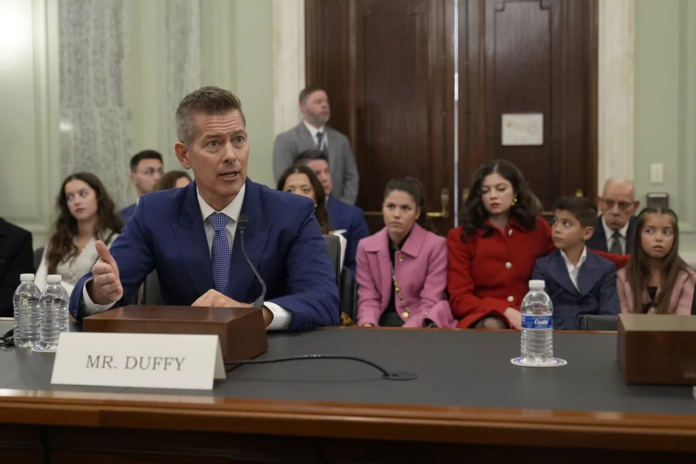The Trump administration will prioritize birth rates in doling out transportation projects, testing out a rising philosophy of conservative politics, and punishing blue cities in the process.
Transportation Secretary Sean Duffy, the father of nine children, released an undated memo saying the department will act on “sound economic principles” while maximizing benefits for families, representing a new direction for the agency and a new way of thinking about federal projects.
Duffy’s memo indicates that environmental concerns will be given less emphasis, which was expected given the switch from a Democratic to a Republican administration, but the eyebrow-raising line spells out that places with more marriages and babies will get a leg up when applying for DOT projects.
DOT will “give preference to communities with marriage and birth rates higher than the national average,” the memo reads, a 14-word phrase that set off alarms across Washington, D.C.
Sen. Richard Blumenthal (D-CT) called it “deeply frightening” and something the Chinese Communist Party might do, while Sen. Patty Murray (D-WA) dubbed it “disturbingly dystopian,” according to the Associated Press. Kevin DeGood, a housing and infrastructure policy expert at the Center for American Progress, said the move was “bizarre and a little creepy.”
Yet even on the Right, setting policy based on birth rates might have seemed strange a few years ago, when the Republican Party was best known for its libertarian emphasis on free markets and economic growth. That stance has changed somewhat as the GOP reexamines how its policies affect ordinary people.
“There are plenty of Republicans who are skeptical about any effort to rely on public policy to encourage marriage or family formation,” said Brad Wilcox, a senior fellow at the Institute for Family Studies. “But there is a rising generation of staffers and populist Republicans who are more open to pursuing policies, measures like this.”
Along with Duffy, Wilcox named Sen. Josh Hawley (R-MO), Secretary of State Marco Rubio, and Vice President JD Vance as members of that rising generation.
“I do think it’s important for federal agencies to think about how the work they’re doing is conducive to family formation,” Wilcox said.
Duffy’s memo also comes as birth rates continue a two-decade decline across the United States.
The number of births in the U.S. peaked in 2007 at more than 4.3 million, according to the Centers for Disease Control and Prevention, and has fallen steadily ever since, with under 3.6 million people born in the country in 2023. Over the same time frame, the general fertility rate declined from 69.3 births per 1,000 women to 54.5, a record low.
While this initiative aims to reward family formation, DOT also justifies its stance by saying projects will go to areas with rising populations, which presumably would need them in years to come.
Elsewhere in the memo, DOT says it will try to avoid adverse impacts on families, prioritize accessibility of transportation to families with young children, prohibit project recipients from requiring masks or vaccines, and require compliance with federal immigration authorities.
All of those factors will test blue cities, which tend to have the lowest birth rates and are often self-designated sanctuary jurisdictions that do not assist in reporting immigration status to federal authorities.
Duffy and the Trump administration will be in charge of billions of dollars worth of unspent funds from the $1.2 trillion infrastructure law passed in 2021, one of former President Joe Biden’s signature achievements.
According to the latest figures from the CDC, all of the 14 states with the highest birth rates backed President Donald Trump in last November’s election, while the bottom 11 states plus the District of Columbia supported Democratic candidate Kamala Harris. Marriage rates are also higher in red states, though by a smaller margin.
If it were a state, D.C. would have the lowest birth rate in the nation, meaning it can expect to see relatively fewer new transportation projects in the future. Rural South Dakota, by contrast, has the nation’s highest fertility rate.
One criticism of the new initiative is that people do not necessarily live where they are born. Big cities, in particular, are places people often move to in young adulthood, leaving their suburban or rural surroundings behind.
Yet, providing opportunities for people where they live rather than forcing them to move for work has become a major tenet of conservative philosophy, underpinning Trump’s strength in the Rust Belt and his plans to rebuild the manufacturing economy in the heartland.
“Families and children are the foundation to a strong society, and by investing in them, we invest in the strength and future of our country,” a DOT spokesperson told the Washington Examiner, adding that population growth is one of many factors considered in project evaluation.
Republicans have been increasingly vocal about the topic as birth rates decline. Vance, a father of three and an early voice in warning about the “baby bust,” speaks frequently about making the GOP and the nation pro-family.
His remarks at the annual March for Life event on Jan. 24 went far beyond simply opposing abortion, instead actively calling for more births.
“Let me say very simply, I want more babies in the United States of America,” Vance said in the speech’s most memorable line. “I want more happy children in our country. And I want beautiful young men and women who are eager to welcome them into the world and eager to raise them.”
JD Vance:


